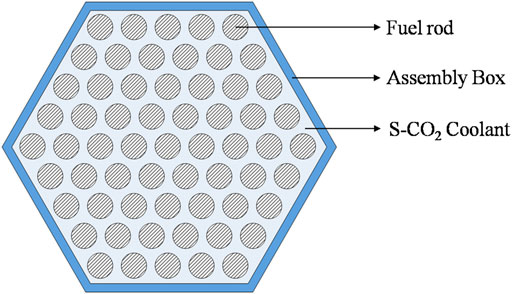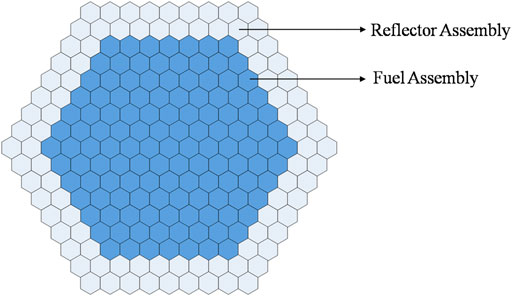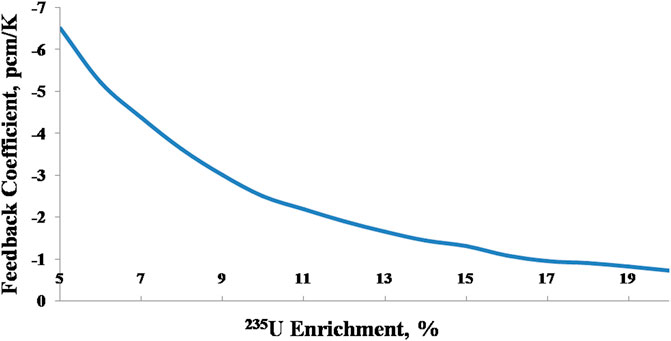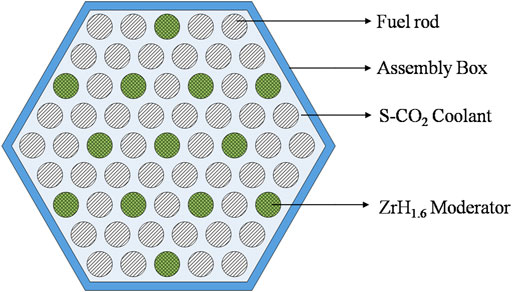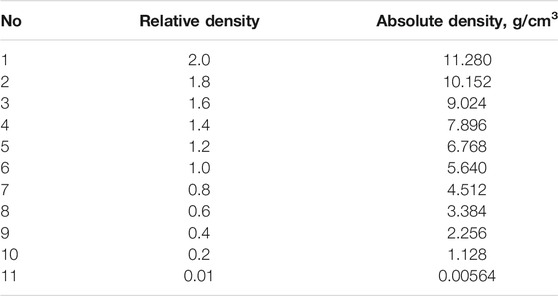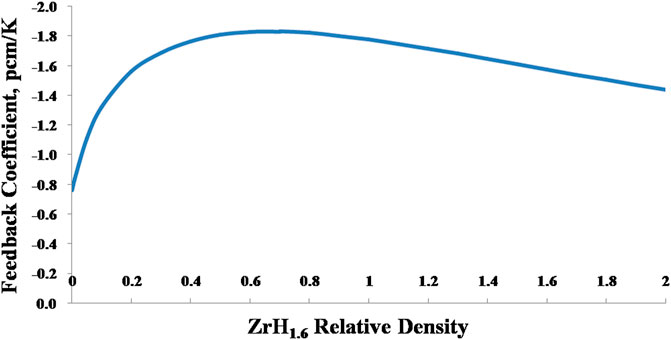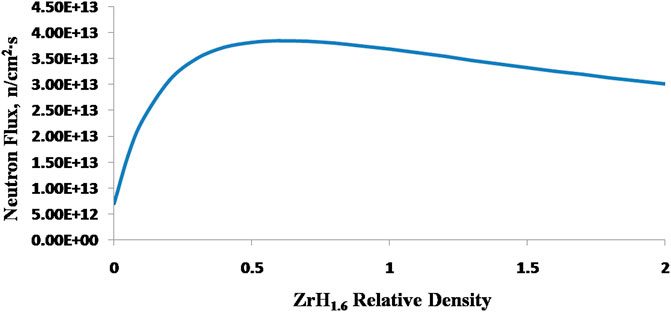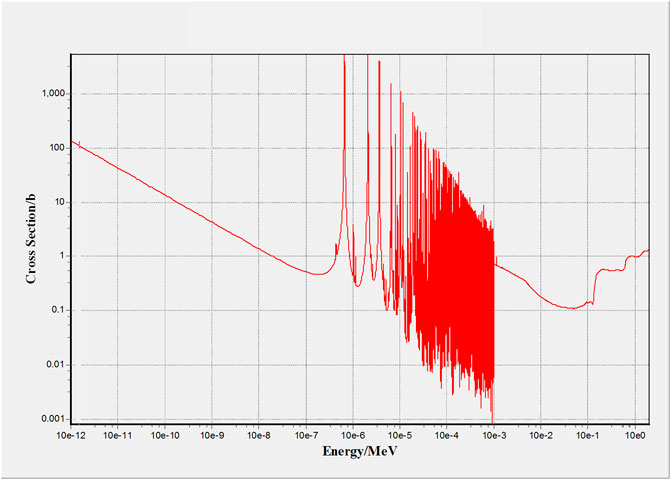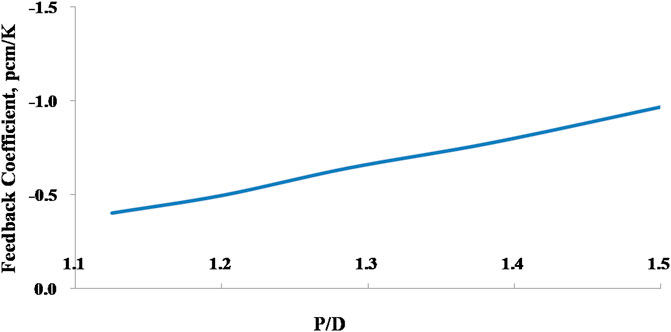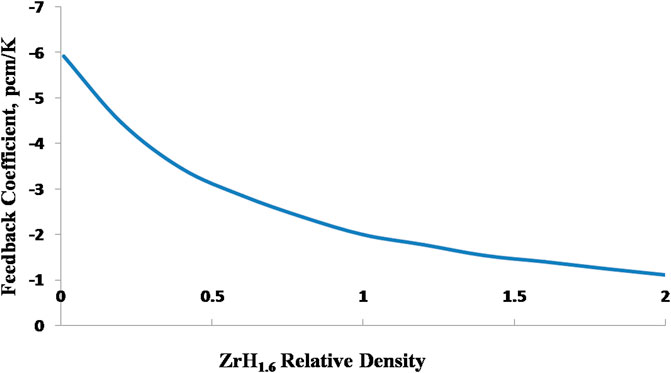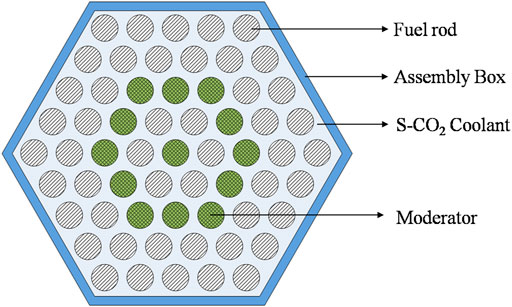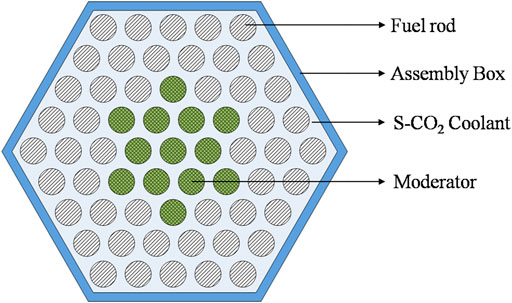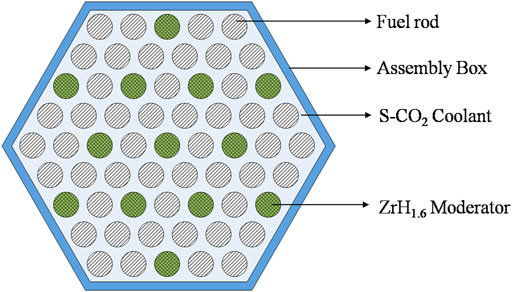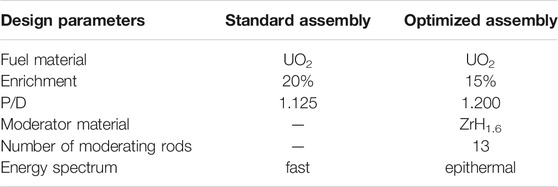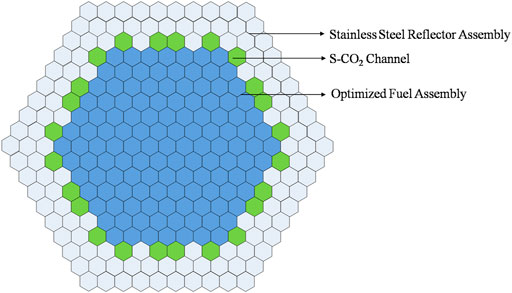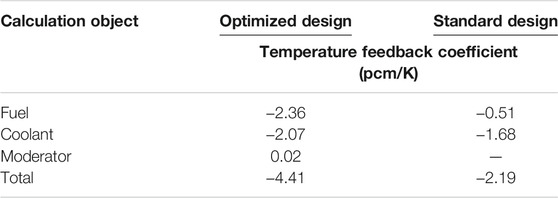- Science and Technology on Reactor System Design Technology Laboratory, Nuclear Power Institute of China, Chengdu, China
As a potential new-type reactor, the supercritical CO2 (S-CO2)–cooled reactor has several advantages, such as being a simple system, having high thermal efficiency, having a small size, and being lightweight. Due to the poor neutronics moderation performance, the S-CO2–cooled reactor shows the disadvantage of a weak temperature feedback effect on reactivity. In this article, the neutronics performance of the reactor has been focused on, and the effects of temperature feedback on fuel, coolant, and moderator studied and the method to improve temperature feedback of the S-CO2 reactor proposed.
Introduction
As a supercritical fluid, supercritical CO2 (S-CO2) presents a homogeneous fluid state. Moreover, it has special properties, i.e., low viscosity and high density, and is considered to be one of the most promising working mediums for energy transmission and energy conversion (Ahn et al., 2015). The S-CO2–cooled reactor has the advantages of being a simple system, having high thermal efficiency, having a small size, and being lightweight and has become one of the most promising reactors. The United States (Michael, 2004; Carstens et al., 2006; Michael, 2006; Handwerk et al., 2007), the European Union (Petr and Kolovratnik, 1997), Japan (Kato et al., 2001; Kato et al., 2004; Tsuzuki et al., 2007), and South Korea (Eoh et al., 2008) have carried out research on the application of S-CO2 to nuclear energy systems.
The reactivity temperature feedback effect is an important factor in maintaining the safety of the reactor (Xie, 1994), and it directly determines the inherent safety of the reactor. Unlike light water coolants or heavy water coolants (Zhang et al., 2019; Zhang et al., 2020), S-CO2 has weak neutron-moderating performance. This “weak moderating” feature, on the one hand, leads to a weaker reactivity temperature effect of the coolant; when the temperature of the coolant rises, the effect of density variation on the moderating performance is limited, making the core coolant reactivity temperature effect weak and even positive; on the other hand, the harder energy spectrum of the neutrons reduces the fuel Doppler effect and makes the fuel temperature effect weak. When positive reactivity is imported into the reactor abnormally, relying on its own reactivity temperature effect, the core temperature must be increasing greatly to suppress reactivity elevating, which brings great challenge to the high temperature resistance of the fuel cladding and reactor structural materials and has an adverse effect on the safety of the reactor. This defect is more serious in the S-CO2–cooled reactor.
Based on the “weak moderation” of S-CO2, this article studies the influence mechanism of core reactivity temperature feedback effect from the aspects of fuel, moderator, and coolant, and then proposes a method to improve the reactivity temperature feedback effect of the S-CO2–cooled reactor.
The Standard S-CO2 Reactor Core Description
The Standard S-CO2 Fuel Assembly
The standard fuel assembly of the S-CO2–cooled reactor in this article is shown in Figure 1. A dense arrangement of fuels is adopted in assembly, and the fuels are placed in a regular triangular pattern. The assembly design parameters are given in Table 1.
The Standard S-CO2 Assembly Arrangement Scheme
The standard S-CO2 assembly arrangement scheme is shown in Figure 2. The standard S-CO2–cooled reactor core consists of 127 assemblies, whose center distance is 92.00 mm, and the active core height is 1,000.00 mm. Two layers of stainless steel assemblies are arranged in the radial direction, and a 300.00-mm thick stainless steel layer is arranged in the axial direction.
Calculation Condition
This study uses the RMC (Reactor Monte Carlo code) for calculation and analysis. In order to calculate the reactivity feedback coefficient caused by the temperature change of each material, the calculated temperature is specified as follows:
Normal state: all the materials at 700 K.
Changed state: the temperature of each material was raised by 200 K. When performing coolant analysis, the coolant density also varies with temperature.
On the one hand, this calculation method can cover the temperature range of the reactor coolant; on the other hand, it can make reactivity change greatly and avoid the influence of program statistical deviation on the analysis result.
The calculation conditions of RMC are set as: 100,000 particles and 500 generations.
Calculation of Temperature Feedback Coefficient
The temperature feedback coefficient is shown in Table 2; the fuel temperature feedback coefficient is −0.51 pcm/K, coolant temperature feedback coefficient is −1.68 pcm/K, and total feedback coefficient is −2.19 pcm/K.
Study on Fuel Temperature Feedback Effect
The fuel temperature feedback effect is mainly affected by the Doppler broadening effect of the heavy nucleus. Among them, 238U and 240Pu contribute the most. As the fuel temperature increases, the effective resonance absorption cross section increases, and the reactivity decreases accordingly, so the fuel temperature coefficient is always negative. The main parameters that affect the Doppler broadening effect, including fuel type, fuel enrichment, and neutron energy spectrum, are studied in this article.
Fuel Type
Typical fuel materials are selected for research, including UN, UC, UO2, and U-10Zr (U-Zr alloy, where the phase volume of Zr is 10%). The results are shown in Table 3. It shows that under typical enrichment, the use of UO2 can obtain the strongest fuel temperature feedback effect, while U-10Zr the weakest one.
The feedback effect of different fuel materials is different when the 235U enrichment remains the same. The reason for this phenomenon is that different fuel materials have different neutron energy spectrums due to their different densities and compositions, and then the different neutron energy spectrums and fuel densities lead to different fuel feedback effects. UO2 has the softest neutron spectrum which gives it the strongest fuel temperature feedback effect.
Fuel Enrichment
Analyzing the influence of 235U enrichment on the fuel temperature feedback effect.UO2 is used for fuel material and the enrichment of 235U varies within the range of 5–20%. The results are shown in Figure 3. With the increasing of 235U enrichment, the fuel temperature feedback effect shows a downward trend.
When the enrichment increases, on the one hand, the content of 238U decreases, and the Doppler broadening effect caused by 238U is weakened, which leads to the weakening of the fuel temperature feedback effect; on the other hand, the content of 235U increases, and the neutron energy spectrum then becomes harder, leading to the further weakening of the fuel temperature feedback effect.
The Neutron Energy Spectrum
Analyzing the influence of the neutron energy spectrum on the fuel temperature feedback effect. UO2 is used for fuel material and the enrichment of 235U is 15%. As shown in Figure 4, in order to achieve the neutron energy spectrum softening, the ZrH1.6 rods, which have good moderating performance, replace parts of the fuel rods in the standard assembly. Densities of ZrH1.6 are given different values, as shown in Table 4, to adjust the degree of neutron moderating, and then achieve different neutron energy spectrums. The calculation results are shown in Figure 5. The absolute value of the fuel temperature feedback coefficient presented earlier increases, and later decreases the trend.
The trend shown in Figure 5 is related to the 238U resonance absorption effect under different neutron energy spectrums. Figure 6 shows the curve of the neutron flux changing with the ZrH1.6 content in the 238U resonance absorption region (Figure 7, 0.0l eV–104 eV), and it can be seen that the neutron flux in the resonance region shows a trend of first increasing and then decreasing, which is consistent with the trend of the fuel temperature feedback coefficient. The reasons for the above trend are as follows: in the low-density areas of ZrH1.6, the neutrons cannot be sufficiently moderated. As the density of ZrH1.6 increases, a large number of neutrons are moderated and fall into the resonance absorption region of 238U, where the resonance effect is obvious, then this phenomenon makes the absolute value of the fuel temperature coefficient increase. In the high-density areas of ZrH1.6, the neutron cannot be sufficiently moderated, as the density of ZrH1.6 increases, lots of neutrons escape from the resonance region as they are further moderated, and then this phenomenon makes the absolute value of the fuel temperature coefficient decrease.
Study on Coolant Temperature Feedback Effect
When the temperature of the S-CO2 coolant changes, the density of S-CO2 changes. Due to the neutron moderation ability of the S-CO2 being weak, the change in its density hardly affects its moderating performance. The change of S-CO2 density mainly affects neutron leakage, which mainly affects the reactivity. The main parameters that affect the coolant temperature feedback effect, including coolant volume fraction and neutron energy spectrum, are studied in this article.
Coolant Volume Fraction
The coolant volume fraction in the core is mainly determined by the ratio of pitch to diameter (P/D), and there is a positive correlation between the coolant volume fraction and P/D. Under the premise of keeping the pitch constant, by setting different fuel rod diameters, the P/D is changed to obtain different coolant volume fractions (Table 5), and different fuel densities are set to keep the fuel weight the same in different rod diameters.
Figure 8 presents the coolant temperature feedback coefficient versus P/D. The absolute value of the coolant temperature feedback coefficient has an upward trend with the increase of P/D.
The trend shown in Figure 8 is related to the influence of S-CO2 density change on the leakage of neutrons. With the increase of coolant volume fraction, the influence of the neutron leakage on the temperature feedback effect is greater. Therefore, a higher P/D design is beneficial to improve the negative temperature feedback effect of the S-CO2–cooled reactor.
The Neutron Energy Spectrum
Analyzing the influence of neutron energy spectrum on the fuel temperature feedback effect. The same moderating method as provided in The Neutron Energy Spectrum section under the Fuel Enrichment section is adopted: 13 ZrH1.6 rods replace parts of the fuel rods, and different ZrH1.6 densities are set to achieve different neutron energy spectrums.
Figure 9 presents the coolant temperature feedback coefficient versus ZrH1.6 density. The absolute value of the coolant temperature feedback coefficient has a downward trend with the increase of ZrH1.6 density.
The trend shown in Figure 9 is related to the influence of the neutron energy spectrum on the neutron leakage. As the ZrH1.6 density increases, the neutrons are moderated, resulting in a shorter neutron-free path, then the neutron leakage effect is reduced. Weakening the neutron leakage leads to a decrease of the feedback effect. Therefore, a harder neutron energy spectrum design is beneficial to improve the negative temperature feedback effect of the S-CO2–cooled reactor.
Study on Moderator Temperature Feedback Effect
Due to the weak moderating performance of S-CO2, the reactor usually uses the solid moderator in the assembly to achieve neutron moderating. Unlike water, the density of the solid moderator is negligible with temperature, and the temperature feedback effect of the moderator is mainly influenced by the cross section of the moderator. The main parameters that affect the temperature feedback effect of the moderator, including moderator material, and the moderator arrangement are studied in this article.
Moderator Type
Typical moderator materials are selected for research, including ZrH1.6, BeO, and graphite. Figure 4 presents the arrangement of moderators in assembly.
The calculation results are shown in Table 4. No matter what material is adopted, the feedback coefficient is close to zero.
The result shown in Table 6 is caused by the negligible change in the moderation performance of solid moderators. Since the density changes very little with temperature, there is almost no change in the moderating performance, resulting in the temperature feedback effect of the solid moderator becoming negligible.
Moderator Arrangement
Typical moderator arrangement forms are selected for research, including distributed arrangement (shown in Figure 4), circular arrangement (shown in Figure 10), and compact arrangement (shown in Figure 11).
The calculation results are shown in Table 7. For BeO and graphite, the temperature coefficient is close to zero regardless of the arrangement. For ZrH1.6, the effect of the arrangement on the temperature feedback is very obvious. With compact arrangement, the temperature coefficient reaches +1.82 pcm/K, which cannot be ignored.
The above phenomenon is mainly caused by the “cell effect” of ZrH1.6. In the ZrH1.6 moderator, the hydrogen nuclei are trapped in the zirconium lattice. The fast neutrons collide with the hydrogen bound to the lattice and gain energy with an integer multiple of hv = 0.137eV from the excited oscillators. As the temperature rises, the number of excited oscillators increases, thus increasing the probability of the neutrons gaining energy. The neutrons that gain energy escape from the moderator and enter the fuel region, and the probability of the neutrons being absorbed by the fuel increases, which increases the reactivity. This phenomenon is more obvious when the compact arrangement is adopted, thus introducing the positive temperature feedback effect. To further study the effect of the compact arrangement on the temperature feedback, we gradually increased the number of moderating rods in the study. The results are shown in Table 8, and these show that with the increase of the number of ZrH1.6 moderating rods, the positive temperature feedback effect brought by the compact arrangement is more and more obvious, and the temperature feedback effect constant zero when BeO or graphite is used as the moderator. Therefore, it is necessary to avoid the compact arrangement of ZrH1.6 in the S-CO2–cooled reactor design.
Design on S-CO2–Cooled Core for Increasing Temperature Feedback Effect
According to the study in the sections Study on Fuel Temperature Feedback Effect, Study on Coolant Temperature Feedback Effect, and Study on Moderator Temperature Feedback Effect, we obtain the method to enhance the temperature feedback effect. This method is applied to the S-CO2–cooled core optimized design.
Optimized Design of Fuel Assembly
Based on the standard S-CO2 fuel assembly, an optimized assembly design is adopted for increasing the temperature feedback effect. Figure 12 presents the optimized design of the fuel assembly, and Table 9 presents the comparison of the standard assembly and the optimized assembly. The optimization methods used for the optimized assembly are as follows:
1) Decreasing the fuel enrichment.
The effect of fuel enrichment on fuel temperature feedback is given in the Fuel Enrichment section. Using fuel with lower enrichment can effectively enhance the fuel temperature feedback effect, then the fuel enrichment decreases from 20 to 15% in the optimized assembly design.
2) Increasing the P/D.
The effect of the P/D on coolant temperature feedback is given in the Coolant Volume Fraction section. Using a larger P/D can effectively enhance the coolant temperature feedback effect, then the P/D increases from 1.125 to 1.200 in the optimized assembly design.
3) Adding moderating rods.
The effect of neutron energy spectrum on fuel temperature feedback is given in the The Neutron Energy Spectrum secton under the Fuel Enrichment section, and the effect of the moderator arrangement on moderator temperature feedback is given in the Moderator Arrangement section. Using ZrH1.6 moderator can effectively enhance the fuel temperature feedback effect, and a distributed arrangement is adopted to avoid the positive moderator temperature feedback. Therefore ZrH1.6 moderator is adopted in the optimized design and the number of moderating rods is 13.
Optimized Design of S-CO2–Cooled Core
Based on the standard S-CO2 assembly arrangement scheme, the optimized core design is adopted for increasing temperature feedback effects. Figure 13 presents the S-CO2–cooled core, consisting of 127 optimized assemblies.
To further enhance the coolant temperature feedback effect, a larger coolant volume fraction is recommended in the Coolant Volume Fraction section. A circle of coolant channels is arranged around the fuel zone to increase the coolant volume fraction in the optimized core design.
Calculation of Temperature Feedback Coefficient
The temperature feedback coefficient is shown in Table 10; the fuel temperature feedback coefficient is −2.16 pcm/K, coolant temperature feedback coefficient is −2.07 pcm/K, moderator temperature feedback coefficient is 0.02 pcm/K, and the total feedback coefficient is −4.41 pcm/K.
In terms of fuel temperature feedback, ZrH1.6 moderators are adopted in the optimized design. The energy spectrum is softened and the Doppler broadening effect increases. In addition, lower enrichment of fuel is selected in the optimized design. These designs can significantly enhance the fuel temperature feedback effect. The fuel temperature feedback coefficient changes from −0.51 pcm/K to −2.36 pcm/K.
In terms of coolant temperature feedback, although the softening of the energy spectrum will lead to the weakening of the feedback effect, the larger P/D design and coolant channel design can increase the coolant volume fraction, such that the feedback effect can be improved. The coolant temperature feedback coefficient changes from −1.68 pcm/K to −2.07 pcm/K.
In terms of moderator temperature feedback, the use of moderator imports moderator temperature feedback effect. The temperature coefficient of the moderator is only 0.02 pcm/K due to the distributed arrangement.
In conclusion, the total temperature feedback coefficient of the optimized design reaches −4.41 pcm/K, which is obviously stronger than the standard design.
Conclusions
Due to the poor neutronics moderation performance, the S-CO2–cooled reactor shows the disadvantage of a weak temperature feedback effect on reactivity, which directly influences the inherent safety of the reactor.
In this article, the influence mechanism of core reactivity temperature feedback effect is studied, and the optimized design of an S-CO2–cooled reactor which has a stronger temperature feedback effect on reactivity is proposed at last. The main conclusions of the study are as follows:
1) The main factors affecting S-CO2–cooled reactor temperature feedback include fuel, coolant, and moderator.
2) In terms of fuel temperature feedback, using UO2 fuel and low enrichment design can effectively improve temperature feedback effect. The neutron energy spectrum also has an important influence on the feedback effect, and increasing the neutron flux in the 238U resonance region is conducive to enhancing the effect.
3) In terms of coolant temperature feedback, using larger coolant volume fraction and hard energy spectrum can improve temperature feedback effect.
4) In terms of moderator temperature feedback, the feedback effect of BeO and graphite moderators can be ignored no matter what arrangement is adopted. For ZrH1.6, there is a strong positive temperature feedback effect when using the compact arrangement, which must be avoided in the design.
5) In terms of moderator temperature feedback, based on the study of fuel, coolant, and moderator temperature feedback effect mechanism, an optimized S-CO2–cooled core is proposed, and a high-temperature feedback effect is obtained.
Data Availability Statement
The original contributions presented in the study are included in the article/Supplementary Material, further inquiries can be directed to the corresponding author.
Author Contributions
LW: conceptualization, methodology, and software; DL: visualization and investigation; LY: visualization and investigation; HX: funding acquisition and supervision; CZ: funding acquisition and supervision.
Funding
This work is supported by the National Natural Science Foundation of China (Approved no: 12075228).
Conflict of Interest
The author declares that the research was conducted in the absence of any commercial or financial relationships that could be construed as a potential conflict of interest.
Publisher’s Note
All claims expressed in this article are solely those of the authors and do not necessarily represent those of their affiliated organizations, or those of the publisher, the editors, and the reviewers. Any product that may be evaluated in this article, or claim that may be made by its manufacturer, is not guaranteed or endorsed by the publisher.
References
Ahn, Y., Bae, S. J., Kim, M., Cho, S. K., Baik, S., Lee, J. I., et al. (2015). Review of Supercritical CO2 Power Cycle Technology and Current Status of Research and Development. Nucl. Eng. Technol. 47 (6), 647–661. doi:10.1016/j.net.2015.06.009
Carstens, N. A., Hejzlar, P., and Driscoll, M. J. (2006). “Control System Strategies and Dynamic Response for Supercritical CO2 Power Conversion Cycle[R],”. MIT-GFR-038, Topical Report of Center for Advanced Nuclear Energy Systems in MIT Nuclear Engineering Department.
Eoh, J.-H., Jeong, J.-Y., Han, J.-W., and Kim, S.-O. (2008). Numerical Simulation of a Potential CO2 Ingress Accident in a SFR Employing an Advanced Energy Conversion System. Ann. Nucl. Energ. 35, 2172–2185. doi:10.1016/j.anucene.2008.09.012
Handwerk, C., Driscoll, M. J., and Hejzlar, P. (2007). “Core Design and Performance Assessment for a Supercritical-CO2 Cooled Fast Reactor[R],”. MIT-ANP-TR-113.
Kato, Y., Niktawaki, T., and Yoshizawa, Y. (2001). “A Carbon Dioxide Partial Condensation Direct Cycle for Advanced Gas Cooled Fast and Thermal Reactors[C],” in Proc. of Global 2001, Paris, France.
Kato, Y., Nitawaki, T., and Muto, Y. (2004). Medium Temperature Carbon Dioxide Gas Turbine Reactor. Nucl. Eng. Des. 230, 195–207. doi:10.1016/j.nucengdes.2003.12.002
Michael, A. P. (2004). “Reactor Physics Design of Supercritical CO2-Cooled Fast Reactor [D],” (Cambridge, Massachusetts: Massachusetts Institute of Technology). Master Thesis.
Michael, A. P. (2006). “Thermal Hydraulics Design of a 2400MWth Direct Supercritical CO2-Cooled Fast Reactor [D],” (Cambridge, Massachusetts: Massachusetts Institute of Technology). Ph.D Thesis.
Petr, V., and Kolovratnik, M. (1997). “A Study on Application of a Closed Cycle CO2 Gas Turbine in Power Engineering [R],”. Departmental report Z-523/97, Czech Technical niversity in Prague, Department of Fluid Dynamics and Power Engineering, Division of Power Engineering.
Tsuzuki, N., Kato, Y., and Ishiduka, T. (2007). High Performance Printed Circuit Heat Exchanger. Appl. Therm. Eng. 27, 1702–1707. doi:10.1016/j.applthermaleng.2006.07.007
Xie, Z. (1994). Physical Analysis of Nuclear Reactor Property [M]. Beijing: Atomic Energy Press, 68–71.
Zhang, T., Xiong, J., Liu, X., Chai, X., Li, W., and Cheng, X. (2019). Conceptual Design of an Innovative Reduced Moderation Thorium-fueled Small Modular Reactor with Heavy-Water Coolant. International Journal of Energy Research 43, 8286-8298.
Keywords: supercritical CO2–cooled reactor, neutronics moderation performance, temperature feedback, solid moderator, potential new-type reactor
Citation: Wang L, Lu D, Yao L, Xiang H and Zhao C (2021) Study on Temperature Feedback Effect of Supercritical CO2–Cooled Reactor. Front. Energy Res. 9:764906. doi: 10.3389/fenrg.2021.764906
Received: 26 August 2021; Accepted: 25 October 2021;
Published: 19 November 2021.
Edited by:
Tengfei Zhang, Shanghai Jiao Tong University, ChinaReviewed by:
Shichang Liu, North China Electric Power University, ChinaXiafeng Zhou, Huazhong University of Science and Technology, China
Donghao He, Shanghai Jiao Tong University, China
Zijing Liu, University of South China, China
Copyright © 2021 Wang, Lu, Yao, Xiang and Zhao. This is an open-access article distributed under the terms of the Creative Commons Attribution License (CC BY). The use, distribution or reproduction in other forums is permitted, provided the original author(s) and the copyright owner(s) are credited and that the original publication in this journal is cited, in accordance with accepted academic practice. No use, distribution or reproduction is permitted which does not comply with these terms.
*Correspondence: Lianjie Wang, bWNkMjI2NEAxMjYuY29t
 Lianjie Wang
Lianjie Wang Di Lu
Di Lu